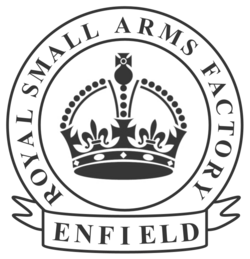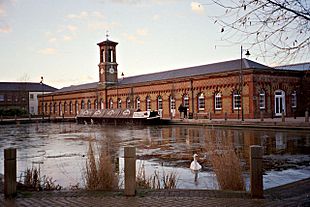Royal Small Arms Factory facts for kids
 |
|
| Private, privatised in 1984, - formerly Government Owned | |
| Fate | Dissolved |
| Successor | Royal Ordnance, then BAE Systems |
| Founded | 1816 |
| Defunct | 1988 |
| Headquarters |
Enfield Lock
,
|
| Products | British military rifles, muskets, swords |
The Royal Small Arms Factory (RSAF) was a special factory in the United Kingdom. It was owned by the government and made weapons. The factory was located in Enfield, right next to the Lee Navigation canal. It also had parts in Waltham Abbey.
From 1816, the factory produced British military rifles, muskets (older types of guns), and swords. It closed down in 1988. However, some of its important work was moved to other places.
The RSAF designed and built many famous weapons for the British Army. These included the Lee–Enfield rifles, which were standard guns used during both World Wars.
Contents
History of the Factory
The RSAF started from a smaller factory in Lewisham in 1807. This earlier site was a mill where armor had been made for hundreds of years. King Henry VIII bought it in 1530, and it became known as the Royal Armoury Mills. It helped supply his armory in Greenwich.
During the Napoleonic War, Britain needed many reliable weapons. So, the government group called the Board of Ordnance decided to build a new, bigger factory.
Building the Factory
The new factory was built at Enfield Lock. This area was a marshy island between the River Lea and the Lee Navigation canal. The land was bought in 1812, and the factory was finished by 1816.
This location was great because:
- Water power from the river could run the machines.
- The Lee Navigation canal allowed easy transport. Raw materials and finished weapons could be moved by barge to the River Thames. From there, they could be loaded onto ships.
Nearby farmland was also bought. This land became a special testing area for weapons from the Royal Gunpowder Mill.
The RSAF was first entirely on the east side of the River Lea. Over time, the river's path changed. This meant part of the factory ended up in Enfield. After the factory closed, the whole site officially became part of the London Borough of Enfield.
Early plans for the factory were very big. They included three mills. Later, an engineer named John Rennie suggested building a navigable channel (a "leat"). This channel was built, but only one mill with two waterwheels was completed.
In 1816, the part of the factory that made gun barrels moved from Lewisham. By 1818, the parts that made gun locks and finished the weapons also moved. This allowed the Lewisham factory to close. A department for making swords was added in 1823.
Growth During Wars
The factory almost closed in 1831, but it survived. It stayed quite small until the Crimean War (1853-1856). This war caused a huge increase in weapon production.
In 1856, a new machine shop was built. It used American ideas for mass-production and was powered by steam engines. The number of workers grew to 1,000. By 1860, the factory was making about 1,744 rifles every week.
In 1866, the factory expanded even more. Steam power completely replaced the watermill. The factory ended up with sixteen steam engines. By 1887, there were 2,400 employees.
Sparkbrook Factory
In 1887, the RSAF bought some workshops in Sparkbrook. These were also called the Royal Small Arms Factory, Sparkbrook. There were also repair shops in Birmingham. By 1893, there were over 2,000 workers at Enfield and over 600 at Sparkbrook. In 1905, weapon making at Sparkbrook stopped. The factory was then bought by BSA.
Production of a new rifle designed by James Paris Lee began in 1889. The very famous Lee–Enfield rifle was designed in 1895.
The 20th Century
The factory grew a lot during World War I and World War II. During World War II, two other factories were set up to make rifles designed at RSAF Enfield. This helped make more weapons and keep production safe from bombing. These other factories, ROF Fazakerley and ROF Maltby, have since closed.
After World War II, the factory started to get smaller. In 1963, half of the site was closed down.
The Royal Small Arms Factory was sold to a private company in 1984. It became part of Royal Ordnance Plc. Later, a company called British Aerospace (BAe) bought Royal Ordnance. BAe closed the Enfield site in 1988.
Why RSAF Enfield Was Important
The factory was created because the British government was unhappy. The weapons used in the Napoleonic Wars were not very good quality and cost too much. At that time, different parts of guns were made by many separate companies, mostly in the Gun Quarter, Birmingham. Then, these parts were put together by hand to make muskets. The Enfield factory was meant to make weapons better and cheaper.
Weapons Made at RSAF Enfield
Almost all the weapons that the Royal Small Arms Factory helped design or produce have "Enfield" or "EN" in their name.

- Enfield Pattern 1853 Rifle-Musket: An early rifle that used special Minié ball bullets.
- Snider–Enfield Rifle: An updated version of the 1853 Enfield from 1866. It loaded from the back.
- Martini–Henry Rifle: A lever-action rifle made from 1871 to 1891.
- Enfield revolver: Standard handguns, with two main types made from 1880 to 1957.
- Martini–Enfield: A version of the Martini–Henry rifle changed to use .303 bullets, from 1895.
- Lee–Enfield rifles: Famous rifles using the Lee bolt action. There were 13 different types made from 1895 to 1957.
- Pattern 1913 Enfield: An experimental rifle from 1913.
- Pattern 1914 Enfield Rifle: Meant to replace the Lee–Enfield, but mostly used by snipers in World War I.
- Bren: A Light machine gun from 1935 onwards. Its name comes from Brno (a city) and Enfield.
- Sten: A 9mm Sub-machine gun made from 1941 to 1953. Its name comes from the designers (Shepherd, Turpin) and Enfield.
- Polsten: A cheaper version of a 20 mm gun, from 1944. Its name includes parts from Polish designers and Sten.
- Taden gun: An experimental machine gun from 1951.
- EM-1: An experimental assault rifle from 1951 with a "bullpup" design.
- EM-2: Another experimental "bullpup" assault rifle from 1951.
- ADEN cannon: A 30 mm cannon for aircraft, used from 1954. Its name comes from Armament Development Establishment and Enfield.
- L1A1 SLR: A British version of the FN FAL rifle, a 7.62 mm Self Loading Rifle, from 1954.
- L42A1: A sniper rifle from 1970, rebuilt from the Lee–Enfield Rifle No 4.
- RARDEN cannon: A 30mm cannon for light armored vehicles, used from 1971. Its name comes from Royal Armament Research and Development Establishment and Enfield.
- ARWEN 37: A 37mm launcher designed for crowd control, used to fire less harmful rounds. Its name means Anti Riot Weapon Enfield.
- SA80: An assault rifle, from 1987.
The RSAF, Enfield, was also famous for its Pattern Room. This was a collection of every type of weapon ever made at the factory. After the factory closed, this collection was moved. It is now kept at the Royal Armouries Museum in Leeds.
What Happened to the Site
After the factory closed, the land was redeveloped. Most of the area is now a large housing development called Enfield Island Village.
The front of the original machine shop and an older part of the back structure were saved. These buildings were turned into workshops and shops. They also house the RSAF Interpretation Centre, where you can learn about the factory. You usually need an appointment to visit.
A pub called The Rifles, which used to be known as the Royal Small Arms Tavern, was bought by the government during World War I. It closed in 2004 after a big fire. Other pubs built for the factory workers, like The Greyhound and The Plough, are still open.
Community Around the Factory
By 1895, the community around the factory had its own school (now gone) and a church (also gone). There was a police station and a fire brigade. Housing for workers was built, like the "Government Row" of cottages.
Several pubs opened near the factory, including The Royal Small Arms Tavern (now Rifles), The Greyhound, Ordnance Arms, and The Plough. The last two are still open today (2021).
You can still see signs of the factory in the area. These include old pill boxes, bridges, and some original buildings like the police house.


